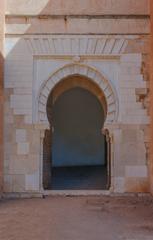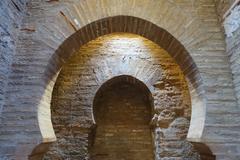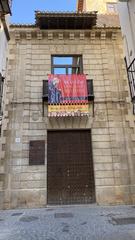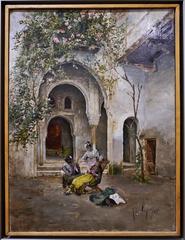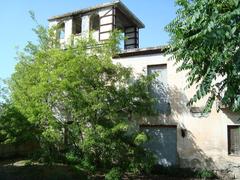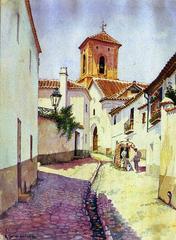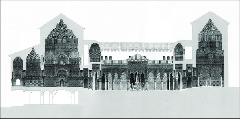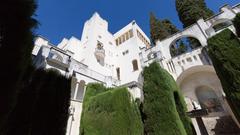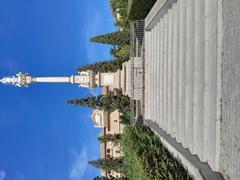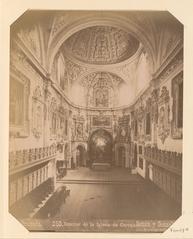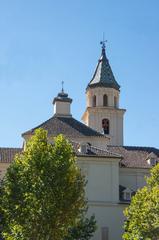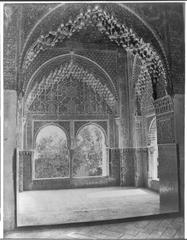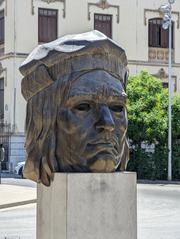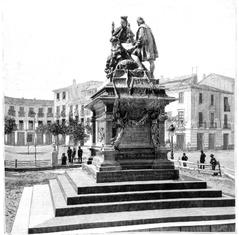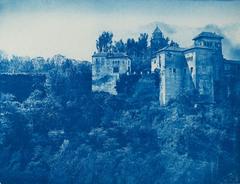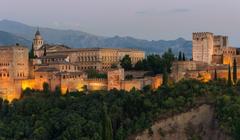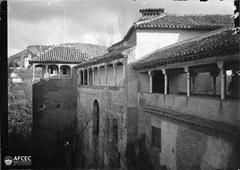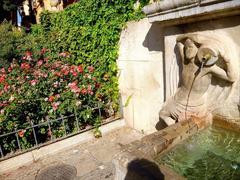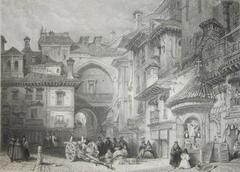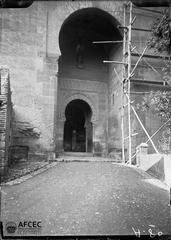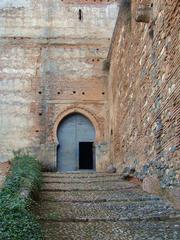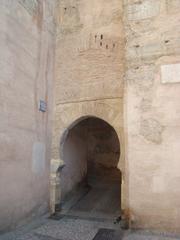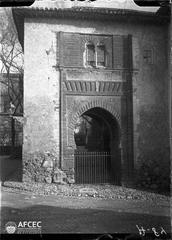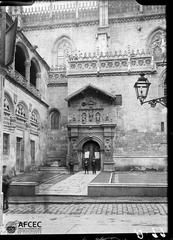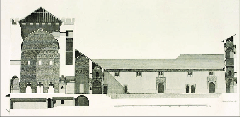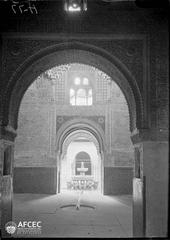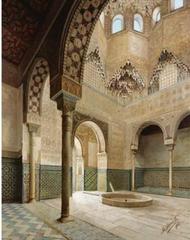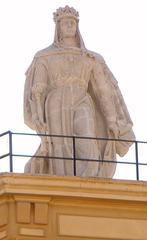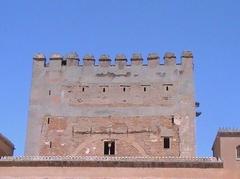
Puerta de los Siete Suelos: Visiting Hours, Tickets, and Comprehensive Guide to Granada’s Historic Gateway
Date: 14/06/2025
Introduction
The Puerta de los Siete Suelos (Gate of the Seven Floors) is one of the Alhambra’s most intriguing and historically rich entrances. Located on the southern flank of Granada’s famed fortress complex, this enigmatic gate stands as a testament to the city’s layered Islamic and Christian past. Although its interior is rarely open to the public, the gate’s imposing façade and evocative legends have made it a focal point for travelers keen to discover Granada’s deeper stories. This comprehensive guide offers historical context, architectural insights, updated visiting hours, ticketing options, accessibility advice, and tips on nearby attractions to help you make the most of your visit to this UNESCO World Heritage site (alhambradegranada.org; nomads-travel-guide.com; official Alhambra website).
Contents
- Historical Overview and Architectural Features
- Cultural Significance and Legends
- Visiting Hours, Ticketing, and Access
- Travel Tips and Accessibility
- Nearby Attractions and Complementary Experiences
- FAQs
- Conclusion and Final Recommendations
- Sources and Further Reading
Historical Overview and Architectural Features
Nasrid Origins and Defensive Design
Built during the 14th-century Nasrid dynasty, the Puerta de los Siete Suelos exemplifies Islamic military architecture. Its original function was defensive, featuring a bent or recodo entrance—forcing attackers to navigate sharp turns under fire—and robust rectangular towers flanking the monumental gate. An inscription above the lintel, “Only God is Victor,” echoes the Nasrid dynasty’s religious and political ethos and also appears on the contemporary Puerta de la Justicia (alhambradegranada.org; alhambraoculta.es).
The “Seven Floors” Mystery
The gate’s name derives from legends claiming it housed seven subterranean levels. Archaeological studies have identified only two underground floors with cylindrical vaults and skylights, likely used for storage, defense, or as dungeons. Its alternate name, “Gate of the Wells,” is linked to the cisterns and dungeons in the adjacent fields, which played a role in both defense and water supply during sieges (alhambradegranada.org).
Christian and Modern Modifications
Following the Christian conquest in 1492, the gate’s role evolved. In the 16th century, a semicircular artillery bastion was constructed, adapting the old Islamic fortification to new gunpowder-era warfare. This addition obscured much of the original Nasrid structure. Significant damage occurred in 1812 when Napoleonic troops partially destroyed the gate. Restoration efforts in the 20th century, particularly under architect Francisco Prieto Moreno, relied on historical documentation to reconstruct the gate as faithfully as possible (andaltura.com; nomads-travel-guide.com).
Decorative Elements and Symbolism
While much of the original stucco and tilework has been lost or hidden, the gate’s scale and strategic placement convey its former importance. The inscription, imposing archway, and bent entrance were designed to awe visitors and deter enemies.
Cultural Significance and Legends
Symbol of Transition
Legend holds that in 1492, Boabdil—the last Nasrid king—departed the Alhambra through this very gate to surrender Granada to the Catholic Monarchs. At his request, the gate remained closed for centuries, symbolizing the end of Islamic rule in Spain (alhambradegranada.org).
Myths and Literary Fame
The gate’s “seven floors” inspired tales of hidden treasures and secret dungeons. Its mystique was popularized by literary works such as Washington Irving’s “Tales of the Alhambra,” further fueling 19th-century fascination with Granada (inspain.news).
Modern Challenges
The Alhambra and its gates face ongoing threats from vandalism and environmental wear. Recent graffiti attacks have prompted public outcry and stricter preservation measures, including heavy fines and potential prison sentences for offenders (inspain.news).
Visiting Hours, Ticketing, and Access
Location and How to Get There
The gate is located on the Alhambra’s southern perimeter, accessible via the Paseo de las Torres and visible from the surrounding Alhambra forest. Visitors can reach it:
- On foot: From Plaza Nueva, walk up Cuesta de Gomérez and follow signs through the Alhambra forest.
- By bus: Take the C3 minibus to the main Alhambra entrance, then follow internal paths toward the Alcazaba and south to the gate (Adventurous Miriam).
- By car: Park in the official Alhambra lot and walk 10–15 minutes through the complex (Adventurous Miriam).
Viewing Hours
- Exterior Viewing: The gate’s façade is visible from public paths during Alhambra grounds’ opening hours.
- April 1 – October 14: 8:30 am – 8:00 pm
- October 15 – March 31: 8:30 am – 6:00 pm
- Interior Access: Generally closed for conservation but occasionally open for special programs such as “Area of the Month.” Check the official Alhambra website for updates (Love Granada).
Ticketing
- Exterior Viewing: Free from public paths (Nomads Travel Guide).
- Special Access: Requires advance booking for guided visits; availability is limited.
- General Alhambra Tickets: Book online up to 90 days in advance; tickets range from €14 to €19, depending on included areas (Traveling with Aga).
Travel Tips and Accessibility
- Best Times to Visit: Early morning or late afternoon for optimal lighting and fewer crowds.
- Accessibility: Paths are steep and uneven. The area is not wheelchair accessible.
- Facilities: Restrooms and refreshments are near the main entrance and Palacio de Carlos V; none directly by the gate.
- Weather: Summers can exceed 35°C—bring water and sun protection.
- Preservation: Respect barriers; drones are prohibited; photography allowed without flash.
Nearby Attractions and Complementary Experiences
Within the Alhambra
- Nasrid Palaces: Masterpieces of Islamic architecture, requiring timed entry (The Viva La Vita).
- Generalife Gardens: Tranquil gardens with fountains and lush plantings—best in spring and summer.
- Alcazaba Fortress: The oldest Alhambra section, offering panoramic city views.
- Fuente del Pimiento & Paseo de las Torres: Nearby scenic walks and peaceful spots (Nomads Travel Guide).
In Granada
- Albaicín District: Moorish quarter with winding streets and iconic viewpoints such as Mirador de San Nicolás (Anywhere We Roam).
- Paseo de los Tristes: Lively riverside promenade with cafes and views of the Alhambra (Explored by Marta).
- Sacromonte: Known for cave houses and flamenco.
- Corral del Carbón: Only surviving Nasrid alhóndiga; entry is free.
- Granada Cathedral & Royal Chapel: Renaissance masterpieces and royal tombs.
- La Alcaicería Market & El Bañuelo: Moorish market and ancient Arab baths.
Culinary and Cultural Experiences
- Tapas Crawl: Enjoy complimentary tapas with drinks at local bars (The Viva La Vita).
- Churros in Bib Rambla Square: Local favorite for a sweet treat.
- Calle Calderería Nueva: Moroccan tea houses and artisan shops.
Day Trips
- Sierra Nevada: Hiking in summer, skiing in winter (Anywhere We Roam).
- White Villages of Andalucía: Picturesque rural escapes.
FAQs
Can I enter the Puerta de los Siete Suelos?
The interior is usually closed, but special guided tours may provide access. Check the official website for current offerings.
Do I need a ticket to see the gate?
No ticket is needed to view it from outside public paths.
Is the area wheelchair accessible?
No; the paths are steep and uneven.
Are there facilities nearby?
Restrooms and refreshments are near the main Alhambra entrance and Palacio de Carlos V only.
What is the best time of day to visit?
Early morning or late afternoon for the best light and fewer visitors.
Conclusion and Final Recommendations
The Puerta de los Siete Suelos is a powerful symbol of Granada’s multicultural history, offering a fascinating glimpse into the city’s past despite limited interior access. Plan ahead by booking tickets early and checking for special guided tour opportunities. Combine your visit with nearby attractions and districts for a rich and immersive Granada experience.
For the latest updates, audio guides, and practical travel information, download the Audiala app and follow official Alhambra channels. Respect the preservation efforts that safeguard this monument for future generations.
Sources and Further Reading
- Alhambra de Granada: Puerta de los Siete Suelos
- Nomads Travel Guide: Torre de los Siete Suelos
- The Viva La Vita: Alhambra Visit Tips
- In Spain News: Graffiti Attacks on Granada’s Historic Sites
- Love Granada: Alhambra Opening Hours
- Andaltura: Puerta de los Siete Suelos
- Official Alhambra Ticketing Website
- Anywhere We Roam: Things to Do in Granada
- Explored by Marta: Granada Bucket List
- Adventurous Miriam: Alhambra Tickets & Map
- Traveling with Aga: Visiting the Alhambra
